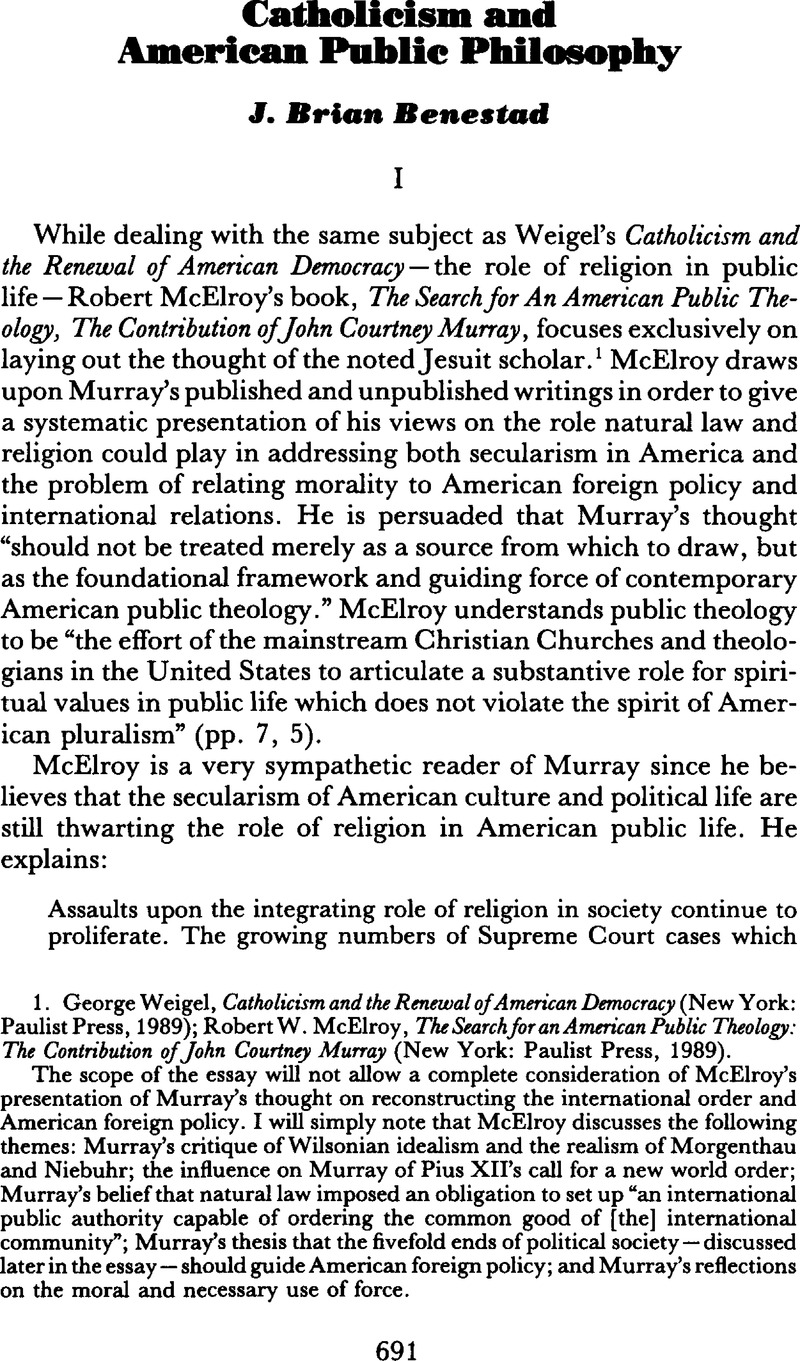No CrossRef data available.
Article contents
Catholicism and American Public Philosophy
Published online by Cambridge University Press: 05 August 2009
Abstract

- Type
- Review Essay
- Information
- Copyright
- Copyright © University of Notre Dame 1991
References
1. Weigel, George, Catholicism and the Renewal of American Democracy (New York: Paulist Press, 1989)Google Scholar; Mcelroy, Robert W., The Search for an American Public Theolog: The Contribution of John Courtney Murray (New York: Paulist Press, 1989).Google Scholar The scope of the essay will not allow a complete consideration of McElroy's presentation of Murray's thought on reconstructing the international order and American foreign policy. I will simply note that McElroy discusses the following themes: Murray's critique of Wilsonian idealism and the realism of Morgenthau and Niebuhr; the influence on Murray of Pius XII's call for a new world order; Murray's belief that natural law imposed an obligation to set up “an international public authority capable of ordering the common good of [the] international community”; Murray's thesis that the fivefold ends of political society —discussed later in the essay — should guide American foreign policy; and Murray's reflections on the moral and necessary use of force.
2. Weigel, p. 204, quoting Neuhaus, Richard J-, The Catholic Moment: The Paradox of the Church in the Post-Modern World (San Francisco: Harper & Row, 1987), p. 283.Google Scholar
3. McElroy, p. 23. See Murray, John Courtney, “On the Structure of the Church-State Problem,” in Gurian, Waldemar and Fitzsimons, M. A., eds. The Catholic Church in World Affairs (Notre Dame, Indiana: University of Notre Dame Press, 1954), p. 14.Google Scholar McElroy provided this source.
4. McElroy, p. 111, quoting Murray, John Courtney, “Law or Prepossessions,” in McCloskey, R. G., editor, Essays in Constitutional Law (New York: Alfred Knopf, 1957), p. 328.Google Scholar
5. McElroy, p. 25, quoting Murray, John Courtney, We Hold These Truths: Catholic Reflections on the American Proposition (New York: Sheed and Ward, 1960), p. 310.Google Scholar (McElroy incorrectly refers the reader to page 320).
6. McElroy, p. 72. See Murray, John Courtney, “Freedom, Responsibility and the Law,” The Catholic Lawyer 2 (07 1956): 214–20.Google Scholar McElroy provided this source.
7. McElroy, pp. 74–75, quoting Murray, John Courtney, “Catholics in America: A Creative Minority,” Catholic Mind 53 (10 1955): 594.Google Scholar There are three ways that Catholics — and other religious communities — could especially fulfill their duty to promote the public philosophy. “The first,” in McElroy's words, “is to encourage talented religious men and women to enter those professions which [have] the power to mold public opinion in the United States — journalism, law, medicine and teaching.” Second, religious communities have to set their sights on educating public officials to apply natural law precepts to public policy. Finally, religious communities have to turn out educated men and women who can competently and persuasively explain the tradition of natural law to the nation's secular intellectuals (see McElroy, p. 75).
8. McElroy, p. 86, 88. See John Courtney Murray, “Analysis for the Rockefeller Brothers' Project,” The John Courtney Murray Papers, Archives of the Georgetown University (hereinafter referred to as JCM Papers).
9. McElroy, pp. 88–89, quoting Murray, John Courtney, “Leo XIII: Two Concepts of Government,” Theological Studies 14 (12, 1953): 554–55.CrossRefGoogle Scholar
10. McElroy, p. 89. See Murray, John Courtney, “Leo XIII: Two Concepts of Government and the Order of Culture,” Theological Studies 15 (03 1954): 14.CrossRefGoogle Scholar McElroy provided this source.
11. See Leo XIII, Rerum Novarum and Immortale Dei.
12. We Hold These Truths, p. 47.
13. Ibid., p. 51.
14. Ibid., p. 54.
15. Murray, John Courtney, “The Declaration on Religious Freedom,” in War, Poverty, Freedom: The Christian Response, vol. 15 Concilium (New York: Paulist Press, 1966), p. 13.Google Scholar
16. Ibid., p. 13.
17. Ibid., p. 14.
18. Ibid., p. 14.
19. Ibid., p. 15.
20. Ibid., p. 15.
21. Ibid., pp. 15–16.
22. Pacem in Terris, No. 54, National Catholic Welfare Conference.
23. Ibid., No. 57.
24. Pacem in Terris, No. 57; Rerum Novarum, No. 57, St. Paul Editions.
25. Pacem in Tents, No. 77.
26. Glendon, Mary Ann, Abortion and Divorce in Western Law: American Failures, European Challenges (Cambridge, MA: Harvard University Press, 1987)Google Scholar, an Rights Talk: The Impoverishment of Political Discourse (New York: The Free Press, 1991).Google Scholar
27. Weigel, p. 110, quoting Sandel, Michael, “The Political Theory of the Procedural Republic,” unpublished paper delivered at the Center on Religion and Society Conference, “Moral Possibilities, Moral Limitations, in the Right Ordering of the World,” New York City, 03 20–21, 1987, pp. 18–19.Google Scholar
28. Dulles, Avery, “Catholicism and American Culture: The Uneasy Dialogue,” America 162 (01 1990): 58.Google Scholar
29. Paul, Pope John II, On Social Concern (Boston: Daughters of St. Paul, 1988), p. 48.Google Scholar
30. Dulles, , “Catholicism and American Culture,” p. 58.Google Scholar
31. Sacred Congregation for the Doctrine of the Faith, Instruction on Christian Freedom and Liberation (New York: Daughters of St. Paul, 1986), No. 75, p. 98.Google Scholar
32. On Social Concern, p. 48.
33. Ibid., p. 71.
34. Ibid., p. 76.


